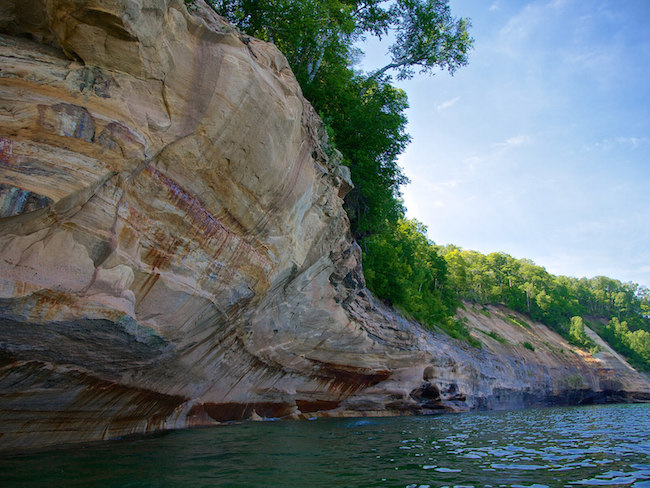
Pictured Rocks National Lakeshore. Image: Flickr, David Marvin
Research at Pictured Rocks National Lakeshore is shedding light on the critical environmental role that shallow seasonal woodland pools of water play in supporting wildlife, a new study shows.
Those isolated pools – technically called “vernal pools” – face direct threats from development and indirect threats from climate change, invasive species, habitat fragmentation, contaminated water and groundwater extraction, according to the study by scientists from Michigan Technological University.
And those threats carry important ecological implications because such pools provide “important sources of food and water for upland terrestrial species, including bats, reptiles, small mammals and birds” in the Upper Peninsula, the study said.
Vernal pools are shallow depressions that fill in the spring or fall but are dry during the summer and drought periods. Few laws protect them, and they’re not covered by the federal Clean Water Act.
The scientists assessed 21 vernal pools in the 71,397-acre national lakeshore, which stretches for 42 miles along the southern shore of Lake Superior. Northern hardwoods, upland conifers, conifer swamps and peatlands dominate the park’s landscape.
The pools, classified into five categories, ranged in size from 12 square yards to 1.5 acres, averaging three-tenths of an acre.
It was tough going, said professor Rodney Chimner, of Michigan Tech’s School of Forest Resources and Environmental Science.
The small and scattered pools were sometimes hard to find “on the landscape in a wilderness area. You have to hike a long ways to get to them,” he said. Also, fieldwork took place in an unusually dry summer, and “by the time we got out there, a lot of the smaller ones were already dry.”
For the project, researchers collected data about vegetation, amphibians, soil characteristics and hydrology, which is the science of water.
They found, for example, 115 species of plants, with the richest variety of species in “forested communities” of red maples and sugar maples.
They also discovered that the diversity of amphibian species varied by types of pools. For example, the American toad was the only amphibian they found in a sugar maple complex, while other types of pools had red-backed salamanders, an Eastern newt, wood frogs and a leopard frog.
Chimner, a co-author of the study, said the biggest surprise was the diversity of pools that the team found.
“The main take-home message we saw from the study is the appreciation that vernal pools are more than just one type. Most land managers, and even scientists, lump them together,” he said.
“There’s a gradient between small and large vernal pools. We can’t just lump them and say that explains all of them.”
While the findings are intended to help public land agencies protect vernal pools, major challenges to conservation exist because of the “inherent variability among vernal pool ecosystems and the inability to prioritize individual pools for conservation,” according to the study.
Variables include the length of the spring wet season and whether a year is drier or wetter than normal.
The newly developed classification system is intended to help public land agencies “effectively maintain a suite of vernal pools across the landscape that are important for all life stages of the variety of species that use vernal pools throughout the year.”
“In the face of threats, including climate change and human development, science-based recommendations are needed to advance conservation of woodland vernal pools,” the study said.
“Using our classification system, managers will be able to effectively maintain a suite of vernal pools across the landscape that are important for all life stages of the variety of species that use vernal pools through the year,” it said.
Chimner said the next step in the research is to use remote sensing technology to conduct a geographically broader survey of the pools, although no funding is available yet to do so.
The study appeared in the journal American Midland Naturalist.